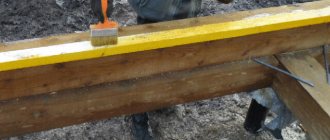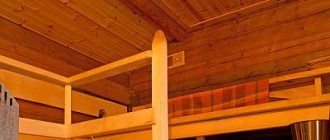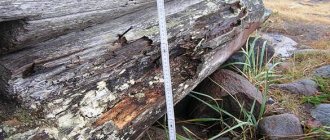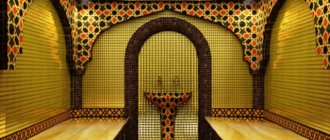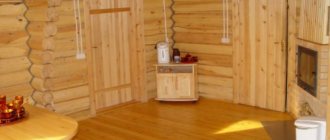Lining is one of the most popular materials for interior decoration of baths. To a lesser extent it is used for cladding facades , but still this possibility of application also exists. Moreover, it is a thin profiled board, most often made of wood, which could use some protection. We will consider in this article whether, where, how and with what to treat the lining in a bathhouse. For those who are just planning to install this material in their bathhouse, we advise you to familiarize yourself with other materials on the topic of lining.
Why do logs rot in bathhouses?
The wooden floor in the bathhouse is pleasant underfoot, retains heat well, looks and smells nice. But the conditions for boards in this building are harsh. High temperature and humidity create conditions for harmful processes - rotting and fungal growth. Rotting is visible on the floor boards, but if the pathological process has affected the joists, the problem will not become noticeable soon.
Causes of log rotting:
- Gaps in the floor through which water penetrates under the boards;
- Poor ventilation, lack of windows;
- The oven is of insufficient size and does not provide the required temperature;
- Improper drainage around the building;
- Presence of rotting areas on floor boards.
If the owner does not carefully monitor the wooden floor in the bathhouse, rotting can destroy the structure in 2-3 years.
Signs of rotting logs:
- Crackling and creaking of the floor with intact boards;
- Mobility of boards for no apparent reason;
- The smell of rot and mold that remains even after cleaning.
Rotten joists do not support the floor Source ytimg.com
Rotting beams release harmful substances into the air, this process intensifies at high temperatures. Entering such a bathhouse does not make a person healthier, but harms the respiratory system and skin. If the process has gone too far, the joists may break under the weight of people at the most inopportune moment.
Recommendations from experts
It is better to treat areas of direct contact with the skin with compounds that do not form a film. But there is a practical solution to this problem. After processing the wood, you need to heat the stove. This promotes deep penetration of the composition. And excess dry residue can be removed with a soft rag.
Shelf processing Source banya-expert.com
What helps against rotting
Rot, like any disease, is easier to prevent than to treat. You need to take preventive measures when laying the floor - immediately treat the beams and boards with a protective compound. When choosing how to treat logs under the floor in a bathhouse, you need to pay attention to the type of substance (impregnation in a bathhouse is more reliable than a film-forming composition) and its interaction with water (the substance should not be washed out).
Industrial impregnation
This technique is used in factories. Wooden products are impregnated with protective substances at high temperature and under pressure. Industrial impregnation protects against rotting, fungi and bacteria. There are fire-fighting compounds and rodent repellents. The main advantage is that industrial impregnation penetrates to the maximum possible depth. The disadvantage is that such logs are more expensive than untreated ones.
Industrial processing solves many problems Source archispace.com
See also: Catalog of companies that specialize in paints and varnishes and related work
Antiseptic impregnations
To save money, you can buy untreated timber and impregnate them with a protective compound yourself. If you properly organize ventilation and drainage in the bathhouse, then such logs can be laid on any base, including earthen ones. Antiseptics for self-treatment are inferior to industrial ones in terms of penetration depth, but if the logs were not initially affected by rot, this does not matter.
Most often in stores you can find impregnations and “Neomid”. When choosing, you need to look at the labeling - the important ones are “for baths and saunas.” They mean that the substance does not contain volatile toxic compounds and is stable at high humidity and temperature.
Operating rules:
- Impregnation is carried out after laying the lags, so as not to disturb the protective layer during fastening;
- You need to work at temperatures from +10⁰ to +50⁰, having previously ventilated the room;
- For application use a brush, roller or spray;
- The impregnation is applied evenly, then allowed to dry for an hour;
Impregnation must be applied evenly Source folksland.net
- The procedure is repeated three times - this creates the most reliable protection against moisture.
After the last layer has dried, you need to additionally coat the logs with varnish, this will protect the impregnation from washing out. The same algorithm works for floor boards. No additional protective equipment is required.
The most thorough treatment is carried out in the washing room - this is the wettest place in the bath. It is not necessary to use varnish in the steam room, but it is important that the impregnation is resistant to temperature. In other rooms, you can limit yourself to a universal mixture for interior work.
The advantages of this treatment are that the owner himself selects the intensity of impregnation and does not overpay for excess substance where it is not needed. Bioprotective agents protect not only from rotting, but also from mold and bacteria. There are also fire-bioprotective agents that will protect the bathhouse from all types of harmful influences.
Disadvantages: time and labor costs. If the treatment was carried out before installing the logs, there is a risk of damaging the protective layer. If you carry it out after installation, the lower parts of the beams will remain untreated. This is not critical on a concrete or pre-treated wood base, but is risky if the base is earthen.
Application of impregnations at the stages of construction and operation of a bathhouse
It is much easier to cover disassembled elements than a finished floor. It is better to soak the boards in the sun; under the influence of ultraviolet radiation, moisture evaporates faster from the deeper layers. Concrete does not need secondary treatment, but wood is renewed after long-term use: the top layer of wood is removed with a sander, then treated with bleaches and impregnations.
Only those areas that have not brightened after sanding are treated with bleach. It is not recommended to bleach all wood completely, although the compositions are considered safe, they still contain some chemicals.
It is better to soak the boards in the sun; under the influence of ultraviolet radiation, moisture evaporates faster from the deeper layers.
How to deal with rot
If the treatment turned out to be insufficient and the joists begin to rot, you can deal with the problem without completely replacing the floor. You need to start the fight against rot with thorough ventilation. Then you need to remove the floor boards, inspect the joists and find all areas of rot. Each affected area must be treated with one of the following compounds:
- Industrial products against rot and mold or other chlorine-based substances. They are used according to the instructions.
- A solution of a mixture of iron sulfate, potassium alum and table salt . Apply to the affected area with a brush. Completely destroys bacteria and fungi. The treatment must be repeated after a month for maximum results.
- Setting fire to sulfur . In the bathhouse, you need to tightly close the windows and ventilation, and exclude access to pets. Sulfur powder is poured into an iron can, set on fire and quickly left the room. Close the door tightly behind you and leave it overnight. In the morning, the bathhouse is opened, the air is disinfected with a bucket of quicklime, and then ventilated. The method is effective, but fire hazardous.
- Hydrogen peroxide . Copes with mold and inhibits the rotting process. Safe for humans at any temperature. The solution is poured onto the affected areas and around them in a thin stream.
To work you need a large bottle of peroxide Source peroxide-prom.ru
Indicators of timber suitability
It is necessary to know about the origin of the wood from which the joists are supposed to be made, because this mainly affects the quality of the floor. When wood is cut for the first time, it must be treated with an antimicrobial compound. Moreover, this must be done in the first 12 hours after sawing.
The next significant factor is drying. There are standards established in 1925, according to which all timber must be stored in a closed warehouse for a certain period. For coniferous trees this period is approximately 1 year, for oak – more than 2 years. In this case, the percentage of humidity is significant, which for spruce and pine is 15-18%.
The logs in the bathhouse can collapse in 1-2 years if you use dry wood to make them and place them on a foundation that is not completely dry. Such timber, if treated with a preservative coating, will become a kind of incubator in which mold will multiply. Therefore, it is necessary to coat only the wood that has actually undergone all the necessary preparation and drying.
How to prevent rotting
The main cause of rotting is construction errors. If they are allowed, then even industrial impregnation will not provide reliable protection against rot and mold. During construction it is necessary to provide:
- Drainage of water from the foundation . Water should not accumulate under the floor or near the bath; a good drainage system is required.
Water should not accumulate near the bathhouse Source vodolov.ru
- Ventilation holes . Vents will prevent moisture from accumulating. To prevent heat from escaping through them, they are closed during washing.
- Window in the washing room and steam room, wide doors . Through them you can quickly release accumulated steam after washing.
- Quality of materials . A tree without cracks, chips, or signs of rot will remain healthy longer.
- Oven size . It must match the size of the bath. A stove that is too small will not provide the required temperature in the steam room, but will create a humid and warm environment in the corners and under the floor.
- Quality of floor installation . If the boards fit tightly, water will not be able to get under the floor.
- Distance from shelves to walls . There should be no gaps between them; this is a direct path to sources of rot.
The bathhouse should be regularly ventilated and cleaned using chlorine cleaners, and the boards should be inspected for rotten areas. This will ensure maximum safety of wooden structures.
Video description
You can learn more about oils for wood processing from the video:
Regardless of the material chosen, it is important to carefully follow the recommendations from the manufacturer. So, to apply the first layer, it is often permissible to dilute the composition, which improves the quality of the finish and reduces consumption. Some products need to be preheated before use, dissolved or simply stirred. The climatic conditions of use are also different, as is the condition of the prepared surface. And also, rarely, but there is weak adhesion of the finishing coating with antiseptics, an additional layer of primer is required.
Varnish for use in the bath Source saunaexpo.com
Briefly about the main thing
When choosing how to cover the boards in a bathhouse on the floor from rotting and moisture, it is better to give preference to industrial compounds that are sold in hardware and country stores. This will reduce the risk of damage to the tree and harm to human health. Properly organized ventilation and water drainage will eliminate the need to deal with rot. Products that are effective against rot, protect against mold, fungi and microbes, and may have additional fire protection.
Ratings 0
Products for treating steam room elements
All products used to process wood inside a bathhouse are divided into two groups: impregnating and coating agents. They are also often divided into colored and colorless, for example, wax, varnish and some impregnations.
Less common are bleaching agents, which are used in cases where the shelves have already darkened. Next, we’ll talk in detail about specific types of processing agents.
Classification of aspen lining
Premium
The most expensive material. Contains no core, knots, or other defects. It has a uniform texture and color.
Class "A"
The wood has no core, but there may be one knot every 1.5 m, a couple of resin pockets and cracks. The texture and color are uniform.
Class "B"
May have up to 4 knots per 1.5 m, a couple of resin pockets and through slots. The lining will most likely contain a stain or stains of contrasting color and mechanical damage.
Class "C"
Lowest quality material. The lining has many knots, cracks, chips and stains. Using this class for sauna cladding is not practical.
Types of lining
Types of lining
They are distinguished by profile type into:
- EURO;
- Soft-line;
- “Tongue and groove along the length”;
- “Tongue and groove and chamfer along the length”;
- "Calm".
The EURO mark tells buyers that the material differs from ordinary lining in quality and size, which directly affects its cost. An important feature is its ergonomics, dimensions and processing are selected so that there is minimal wood consumption.
There are also 2 more differences:
- special groove for water drainage;
- deeper tongue-and-groove connection.
